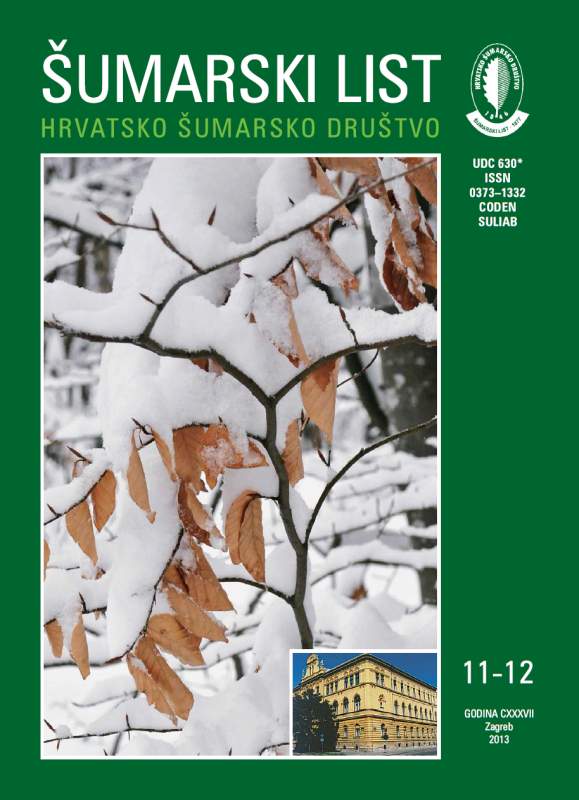
broj: 11-12/2013
pdf (4,23 MB) |
|
||||||||||||||
| RIJEČ UREDNIŠTVA | ||
| uredništvo | ||
| AT THE END OF THE YEAR pdf HR EN | 565 | |
| IZVORNI ZNANSTVENI ČLANCI | ||
| Ivan Perković, Nikola Pernar, Darko Bakšić | UDK 630*114.1 (001) | |
| COMPARISON OF TWO SIEVING AND SEDIMENTATION METHODS FOR DETERMINATION OF PARTICLE SIZE DISTRIBUTION – POSSIBILITIES AND LIMITATIONS OF INTERPRETATION pdf HR EN | 567 | |
| Tarik TREŠTIĆ, Osman MUJEZINOVIĆ, Azra ČABARAVDIĆ, Ismir MURATAGIĆ | UDK 630*412 (001) | |
| IMPACT OF MICRO-LOCALITY FACTORS TO THE INTENSITY OF INFESTATION OF SILVER FIR TREES WITH WHITE MISTLETOE pdf HR EN | 575 | |
| Roman ROSAVEC, Zoran ŠIKIĆ, Željko ŠPANJOL, Damir BARČIĆ | UDK 630*431 + 111 (001) | |
| INFLUENCE OF METEOROLOGICAL PARAMETERS ON FLAMMABILITY OF SOME MEDITERRANEAN SPECIES pdf HR EN | 583 | |
| Summary The Mediterranean ecosystems are affected by human activity, and the present situation is largely a result of intensive human activities and natural changes. Meteorological parameters were having a great impact on the fires. As fires are a natural phenomenon, they are small scale with minor damage can be interpreted as a dynamic natural processes. But the number of forest fires, and thus the size of the burned area, have drastically increased in recent decades. The vegetation of the Mediterranean is specific in many ways, including by cause-and-effect relationship with the forest fires. Specifically, each vegetation type has its own fire regime, and features such as fire interval, the average annual burnt area and severity (intensity of fire). Mediterranean forests are generally poor in terms of the number of species represented. Monodominant are, and as such are easily flammable and subject to the spread of fire from a mixed forest with a large number of species. This paper describes the variation of flammability (ID) major tree species of the Mediterranean area and are presented to estimate the effect of meteorological factors on the above variables. Research was conducted on Teaching Experimental Forest Object Rab Faculty of Forestry, University of Zagreb, and in an experimental laboratory for the protection of forests against fire in Makarska. Tests were carried out in the period of June 2007. until June 2009., one month per location. The results were confirmed by differences in delay between the flammability species tested at all sites, as well as the location of the species tested. The mean delay flammability of all kinds at both sites was 10.60 seconds. The results based on laboratory testing show that they can be directly used in the description and prediction of forest fire when it comes to the flammability of natural fuels in actual site conditions. Key words: flammability; forest fires; meteorological factors; Mediterranean | ||
| Matthias KROPF, Gerald HÖLZLER, Rosemarie PARZ-GOLLNER | UDK 630 * 152 + 135 (Castor fiber L.) (001) | |
| GENETIC EVIDENCE ON THE ORIGIN OF THE CURRENT BEAVER (Castor fiber) POPULATION IN LOWER AUSTRIA pdf HR EN | 591 | |
| Andreas Redin, Göran Sjöberg | UDK 630*151 (001) | |
| EFFECTS OF BEAVER DAMS ON INVERTEBRATE DRIFT IN FOREST STREAMS pdf HR EN | 597 | |
| STRUČNI ČLANCI | ||
| Boris Vrbek | UDK 630 *114.4 | |
| THE PREPARATION METHOD OF FOREST SOIL MONOLITHS WITH THE USE OF EPOXY RESIN pdf HR EN | 609 | |


